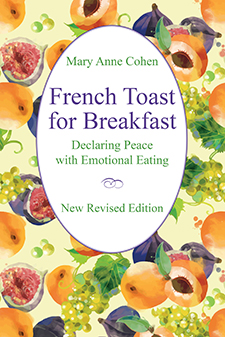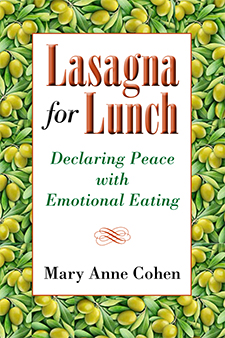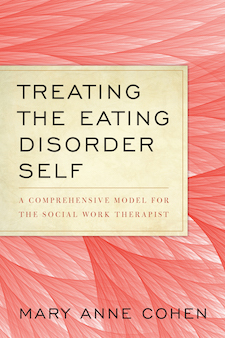Lasagna for Lunch: An Interview by Mary Anne Cohen
1. Early in your book, Lasagna for Lunch Declaring Peace with Emotional Eating, you write, "A person's eating disorder is a creative solution to inner turmoil." Can you please tell us more about this?
In 1982, I coined the term "emotional eating" to describe the varied and conflicted, fluctuating and frustrating relationship many people have with food. When you use eating to detour, distract, or deny your inner emotions, you are seeking a way to make yourself feel better. And it is a healthy and creative act to try to make yourself feel better! Unfortunately eating disorders do not provide a lasting solution to resolve inner turmoil.
Food is the safest, cheapest, most available, socially sanctioned mood altering drug on the market! This mood altering power of overeating, undereating, starving, bingeing, and purging provides a creative resource to help people - albeit temporarily - remove themselves from their struggles with depression, anxiety, anger, or loneliness. Emotional eating is about being hungry from the heart and not from the stomach. Therefore true healing means ultimately learning to separate your food from your feelings and finding emotional nourishing ways to cope with distress. Finding ways to nurture yourself without food is ultimately the most creative process.
2. Can you offer some examples of your use of "the metaphor of a gun to illustrate the origin of an eating disorder?"
Originally, therapists used this concept in the field of addictions to describe the multi-faceted reasons that people turn to drugs and alcohol. However, it is applicable to illustrate the origin of eating disorders as well.
Genes, metabolism, and heredity predispose a person to an eating disorder; this sets the stage and the gun is created. A troubled or unempathic relationship with one’s parents, problems of loss, grief, or abuse, compounded by our culture’s relentless pursuit of thinness, may precipitate an eating disorder; now the gun is loaded. When a particular emotionally distressful event occurs, an eating disorder is then activated; the gun's trigger gets pulled.
Let's use the example of Sandra. Her father was obese with a family history of alcoholism. This genetic background predisposed Sandra to an addictive relationship with food; the gun is created. When Sandra was ten, her parents got divorced and her dad remarried and moved to another state; her unhappiness and sense of loss "loaded" the gun as she turned to overeating for comfort and companionship. But it was only after she left home to go to an out of town college that her anxiety and depression mounted along with her sense of isolation. Sandra began to binge and purge and developed a full blown eating disorder. Her bulimia was triggered and perpetuated by this emotional upheaval until she sought treatment.
3. You discuss attachment and Eating Disorders. Your thoughts?
From the very first moment of our lives, a connection exists between eating and deep emotions. The vital emotions of trust, dependency, security, generosity, and the acceptability of our needs begin at birth in the feeding experience with our parents. Love has its origins in the satisfying feeling of being well-nourished. Family is where we learn to love and where we learn how to be loved.
How we feed ourselves, how we take care of ourselves, how we tend to our own needs is based on these early patterns of how our parents cared or didn't care for us as children. When we are taught that our needs and our hungers are acceptable, we, in turn, learn to care for our needs and our hungers in loving and self-protective ways. With that secure foundation, we do not need to resort to eating disorders to fortify ourselves. This capacity to soothe one’s self may be the key ingredient in preventing an eating disorder!<
But when we are shamed, neglected, or made to feel inadequate, we come to treat ourselves in a similar manner. Eating disorders are attachment disorders. When early attachments fail to nourish, addiction to food or substances becomes an attempt to repair the hurt self—to offer comfort, consolation, and to fill up the vacuum within. Emotional eating takes the edge off anxiety and is easier to control than the uncertainty of human contact. Trusting food can feel safer than trusting people. Loving food can feel safer than loving people. Food never leaves you, never dies, never betrays you. It is the only relationship where we get to say where, when, and how much. No other relationship complies with our needs so absolutely.
Developing healthy attachments through friendships, love relationships, support groups, and psychotherapy provide good medicine for the body, heart, and soul.
4. How can parents "encourage emotions?"
To raise children who will not be susceptible to emotional eating problems, parents need to talk about feelings, listen respectfully to their children and respond empathically to their kids' emotions. When feelings are allowed and easily expressed in a family, children grow up to be expressive adults, at home with their emotions and in their bodies. On the other hand, the best way to create a child with tendencies to emotional eating is to shame him/her for their feelings: "You shouldn't feel that way." "You have nothing to complain about." "Why can't you be more like your sister?" When they are shamed, children push their feelings underground and may resort to bingeing, purging, or starving to vent their stress and frustration.
However, the good news is that parents only have to be "good enough," not perfect in being emotional responsive to their children. A certain amount of frustration is growth-promoting since we all have to grow up and learn to tolerate that the world wasn't put here to meet all our needs.
5. What were/are some of the most meaningful components to your recovery?
As Director of The New York Center for Eating Disorders, I believe that everyone's eating problems are as unique as a fingerprint. I collaborate with clients to help fashion an integrated and comprehensive approach which is responsive to their needs, not a "one approach fits all." In addition, what works at one point in a person's recovery, may change as their healing evolves over time.
For example, where once upon a time, I found the 12 step principles of Overeaters Anonymous valuable, my focus shifted, and I then discovered psychotherapy to be an essential part of recovery. Now, my eating is guided by intuitive eating - listening to my internal clues of hunger and fullness and separating out my emotions from my eating.
6. The one thing I'd like my readers to know is...
A poem I once read said, "Alas for those who die with all their music in them." When we work towards declaring peace with emotional eating, we give ourselves the opportunity to live and express all the rich and varied music within us that has been detoured through emotional eating. Therefore, I want to encourage people to leave no stone unturned to heal themselves.
Life for all of us is at times confusing, exuberant, contradictory, hopeful, messy, joyful, hurtful, and disappointing. Sometimes it’s hard to be a human! We all search for ways to manage life on a daily basis. For the anorexic, bulimic, and compulsive overeater, the ultimate coping mechanism for all of life’s uncertainties and frustrations revolves around eating and weight loss. The language of pain comes in many dialects. Emotional eating problems and the fear of being fat is one such dialect in which we recruit our bodies to express what we cannot utter in words. The language of food and fat is a symbolic one, a way to express our inner emotional battles over feelings of emptiness and fullness, vulnerability and protection, urge and restraint, desire and despair. Eating problems become a vehicle to communicate matters of the heart that have no other channel.
But there is hope! I believe a key ingredient is embarking on the healing conversation of therapy. Therapy provides the bridge between emotional eating and the road to recovery, health, healing, and wholeness.
Other "ingredients" on the menu of recovery include:
-
Cultivating self-compassion is crucial to resolving an eating disorder.
-
Difficult feelings will pass whether or not you eat over them.
-
Change is made by small bite size pieces. You don't have to change your whole eating problem over night. Just commit to one do-able change at a time.
-
Every person's eating problem is unique as a finger print. If you seek help, find a therapist who has a flexible approach and wants to discover what works uniquely for you.
-
Awareness+Action= Results
And finally: Sink your teeth into life, not into your relationship with food!
Published in Gurze.com.



